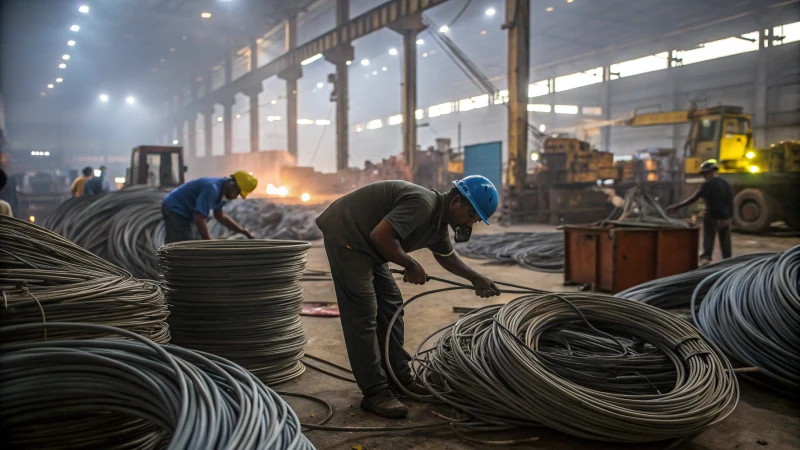
Ever looked at a pile of worn-out steel wire ropes and wondered what next? Well, recycling might just be the answer.
Recycling steel wire ropes from heavy machinery involves collecting, cleaning, and processing them to recover reusable steel. This process includes cutting the ropes into smaller pieces, eliminating contaminants, and melting them down for reuse in new products, helping to reduce waste and conserve resources.
It might sound like a straightforward process, but diving into the nitty-gritty reveals a world of benefits and considerations. I remember when I first learned about how recycling these ropes could transform waste into something useful, it was like discovering a secret superpower. In this blog, we'll explore effective recycling methods, uncover the environmental and economic perks, and discuss how to stay on top of industry standards. Whether you're a veteran in procurement or just starting out, understanding these insights can make a world of difference.
Steel wire ropes must be cut before recycling.True
Cutting is necessary to handle and process steel wire ropes efficiently.
Recycling steel wire ropes increases environmental pollution.False
Recycling reduces waste and conserves resources, decreasing environmental impact.
What Are the Environmental Benefits of Recycling Steel Wire Rope?
Ever wondered how recycling steel wire rope can help save our planet? Let's explore the surprising environmental perks that come with it!
Recycling steel wire rope is a game-changer for the environment. It saves natural resources, slashes energy use, and cuts down greenhouse gas emissions. Plus, it keeps waste out of landfills and boosts the circular economy, making resource management more sustainable.
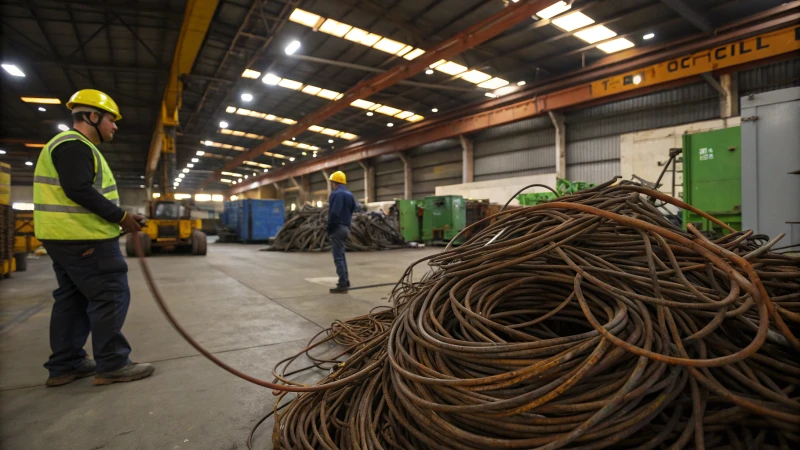
Conserving Natural Resources
Steel wire ropes are mostly made from steel, a material that heavily depends on precious natural resources like iron ore and coal1. By recycling, we're not just cutting down on extracting these resources; we're actually giving Mother Nature a much-needed breather. It's like hitting pause on the relentless demands we place on our planet. Using recycled steel allows industries to significantly minimize their environmental footprint.
Reducing Energy Consumption
I still remember the shock I felt when I learned how much energy goes into making steel from scratch. It’s like lighting up a small town! Recycling steel, on the other hand, uses up to 60% less energy2. That’s a massive reduction and a win-win for both our wallets and the environment. Every bit of energy we save is a step toward reducing harmful emissions and pollutants.
Lowering Greenhouse Gas Emissions
Ever sat down and calculated your carbon footprint? I tried it once, and let me tell you, it was eye-opening. Making new steel is a major source of greenhouse gases, but by recycling steel wire ropes, we can cut these emissions by up to 86%. That's like giving the planet a big, fresh breath of air—an essential step in our fight against climate change.
Minimizing Landfill Waste
We've all seen those sprawling landfills while driving past them, right? It’s alarming how much waste we generate. Steel wire ropes can add significantly to landfill waste if they're simply discarded. But recycling them helps divert this waste from landfills where they’d otherwise sit for ages. Recycling facilities efficiently process large volumes, easing the burden on waste management systems and sparing our environment further degradation.
Supporting the Circular Economy
The circular economy might sound like a buzzword, but it's genuinely transformative. By recycling steel wire ropes, we're not just closing the loop in production cycles; we're actively fostering a market for recycled products. This approach resonates with global sustainability goals and promotes responsible resource management. It’s about keeping materials in play as long as possible, which is not only smart but essential for sustainable living.
| Benefit | Impact |
|---|---|
| Conserves natural resources | Reduced need for raw materials |
| Decreases energy consumption | Up to 60% energy savings |
| Lowers greenhouse gas emissions | Up to 86% reduction in emissions |
| Reduces landfill waste | Less environmental degradation |
| Promotes circular economy | Sustainable resource management |
Recycling steel saves up to 60% energy.True
Recycling steel requires significantly less energy than producing new steel.
Steel wire ropes decompose in landfills in 5 years.False
Steel wire ropes take decades to decompose, not just five years.
How is Steel Wire Rope Recycled?
Have you ever thought about what happens to steel wire ropes once they've served their purpose? Let's dive into the recycling process that transforms these industrial giants into new, valuable materials.
Recycling steel wire rope starts with collecting and sorting, followed by cutting, cleaning, and melting. The purified steel is then reshaped into new products, minimizing waste and conserving resources.
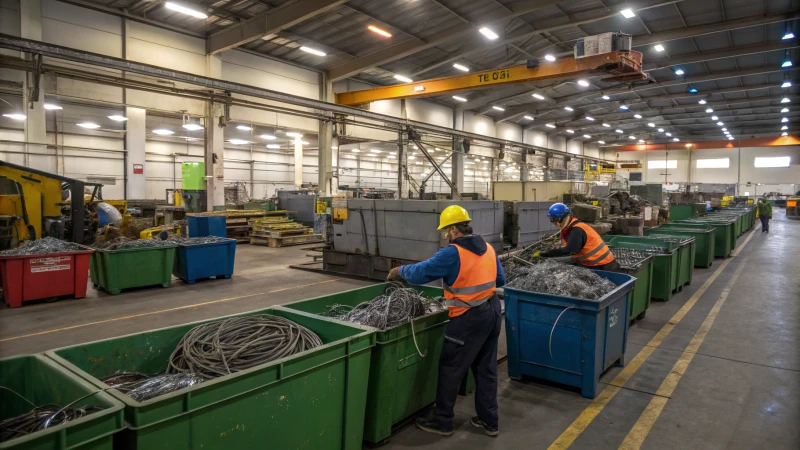
Collection and Sorting
I remember standing on a construction site, surrounded by towering cranes and a maze of cables. It was there that I first learned about the collection phase of recycling steel wire ropes. They're gathered from places like construction sites and mines, where they're no longer needed, ensuring nothing goes to waste.
Cutting and Shredding
Once these ropes are sorted based on their material type and condition, they are cut down to size. I always picture it like trimming overgrown vines in a garden—snip by snip, until everything is manageable. Shredding further breaks them down, readying them for the next steps.
Cleaning
When I think about cleaning these ropes, it reminds me of scrubbing off stubborn stains from an old shirt. These ropes often come coated with grease or oil from their heavy-duty usage. They undergo thorough cleaning to strip away these impurities, ensuring only pure steel remains.
Melting
The cleaned steel then meets the heat of high-temperature furnaces—a bit like turning sand into glass, I suppose. During melting, any lingering impurities are purged, leaving behind high-quality molten steel that's ready to be transformed.
Reforming into New Products
Finally, this molten steel is shaped into new forms. It's akin to watching an artist sculpt clay into a masterpiece. This step completes the cycle, giving life to new products that will support industries around the globe once more.
Environmental Impact
Recycling steel wire ropes isn't just about renewing resources; it's about preserving our planet. By reducing landfill waste and conserving resources, this process cuts down on the energy typically required to create new steel from scratch. It's a win-win for industries looking to embrace sustainability3. For more insights on how this practice supports sustainability goals4 across various sectors, dive into the broader benefits of recycling.
| Process Step | Description |
|---|---|
| Collection | Gathering ropes from various industries |
| Sorting | Categorizing based on material and condition |
| Cutting/Shredding | Breaking down ropes into smaller pieces |
| Cleaning | Removing contaminants such as oil and coatings |
| Melting | Heating cleaned steel in furnaces |
| Reforming | Transforming molten steel into new products |
For more insights on the significance of steel recycling5, consider the environmental benefits and industrial applications. Delve deeper into how this practice aids in achieving sustainability goals6 across sectors reliant on steel products.
Steel wire ropes are sorted by material type.True
Sorting by material ensures efficient recycling and processing.
Recycling steel wire rope requires no energy.False
Melting steel uses high-temperature furnaces, requiring significant energy.
What Are the Challenges in Recycling Steel Wire Ropes from Heavy Machinery?
Ever wondered why recycling steel wire ropes feels like untangling a complex knot? It’s a journey filled with challenges, but understanding them can lead to better solutions.
Recycling steel wire ropes from heavy machinery is challenging due to contamination from oils and grease, difficulty in separating wire strands, and steel degradation over time. Overcoming these issues requires specialized equipment and processes.
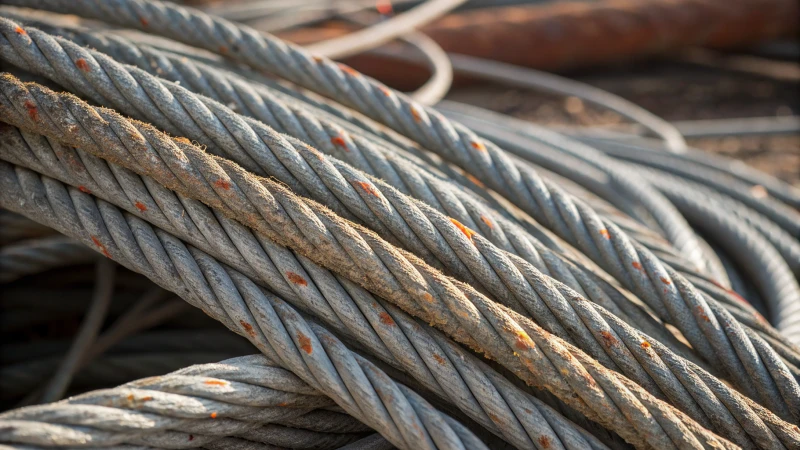
Contamination Issues
I remember the first time I saw a steel wire rope being used in heavy machinery—it was covered in layers of grease and oil, making it look more like an industrial snake than a piece of equipment. This contamination is one of the major hurdles in recycling. The challenge lies in cleaning these ropes thoroughly to maintain the quality of the steel for future use. It's like trying to scrub out a stubborn stain from a favorite shirt—time-consuming and not always successful without the right approach. Specialized cleaning methods7 are crucial here, adding extra layers of complexity and cost to an already daunting task.
Complexity in Separation
Imagine trying to unweave a tightly braided rope with each strand having a mind of its own—that's what it's like to separate the strands of a steel wire rope. These ropes are constructed for maximum strength, meaning the strands are intricately twisted together. Recycling requires advanced machinery8 that can delicately untwist these strands without damaging the material. This process is as delicate as separating two stubborn friends after an argument—it's tricky, requires precision, and needs patience.
Degradation of Material Quality
As I’ve seen with many seasoned tools and materials, time is not always kind. Steel wire ropes are no different. Their constant use leads to wear and tear, gradually degrading their mechanical properties. This degradation affects the quality of the recycled steel, which might limit its potential uses. Assessing this quality becomes vital, ensuring that recycled materials are not just a shadow of their former selves but can still hold their ground in new applications.
Economic Viability
If you've ever tried to balance a household budget, you'll know that sometimes costs can surprise you—like when you find out that recycling steel wire ropes isn't just about saving the planet but also about economic feasibility. The costs involved, including transportation and processing, can be significant. Companies must consider if these costs outweigh the benefits or if there are incentives like government subsidies9 that can tip the scales in favor of recycling.
Table: Overview of Challenges
| Challenge | Description |
|---|---|
| Contamination | Removal of oils and greases is costly and laborious |
| Separation Complexity | Requires specialized equipment for strand separation |
| Material Degradation | Affects quality and limits reuse potential |
| Economic Considerations | High costs may outweigh recycling benefits |
These challenges remind me of the importance of innovation in this field. It's not just about finding quick fixes but developing comprehensive solutions that support sustainable practices across industries.
Contamination removal is cost-effective in steel rope recycling.False
Contamination removal is costly and laborious, increasing recycling expenses.
Advanced machinery simplifies wire strand separation.True
Specialized equipment is required to handle the intricate designs efficiently.
How do companies ensure they meet recycling regulations?
Navigating the maze of recycling regulations can feel overwhelming, but it's crucial for both the planet and your business's success. Let's explore how to turn this challenge into an opportunity for growth and innovation.
To comply with recycling regulations, conduct regular audits, provide employee training, establish a compliance team, and stay informed about local laws. These steps build a sustainable and responsible corporate culture.
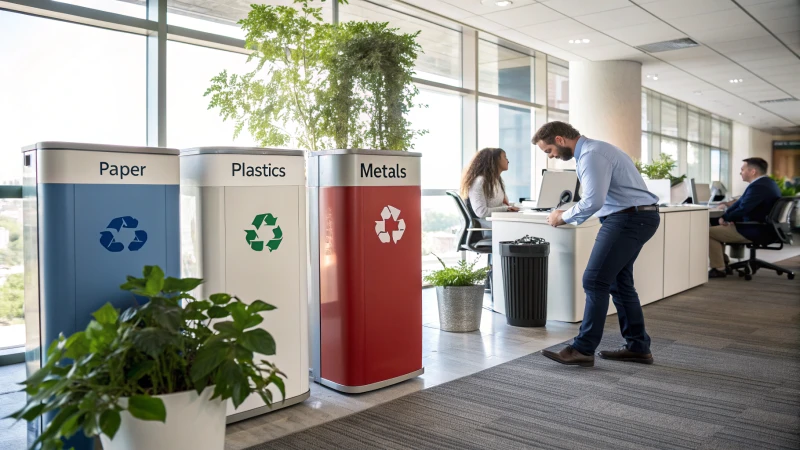
Regular Audits and Assessments
Remember that time when I discovered a minor oversight in our waste segregation during a routine audit? That small check saved us from potential non-compliance fines and sparked a team-wide commitment to better recycling practices. Conducting regular audits is like giving your recycling processes a thorough health check-up. By evaluating waste management procedures and ensuring they align with local laws, companies can spot gaps and make timely improvements.
For instance, organizations can adopt an audit checklist that includes:
| Audit Element | Description |
|---|---|
| Waste Segregation | Ensure proper separation of recyclables from non-recyclables. |
| Documentation | Maintain accurate records of recycling activities and compliance measures. |
| Vendor Assessment | Evaluate the practices of recycling vendors for regulatory adherence. |
These regular assessments are your chance to uncover hidden inefficiencies and strengthen your compliance strategy.
Employee Training Programs
I can't stress enough how eye-opening it was when I participated in a workshop on recycling best practices10. Suddenly, the whole team was buzzing with ideas on how to reduce waste more effectively. Training programs are vital for cultivating a culture of sustainability. Through interactive modules and regular updates, employees learn the impact of their actions and the importance of adhering to recycling regulations.
- Workshops on recycling best practices11
- Interactive modules on environmental impact and sustainability
- Regular updates on new regulations and compliance strategies
These initiatives don't just inform—they inspire everyone to take ownership of their role in our sustainability journey.
Establishing a Dedicated Compliance Team
Creating a dedicated compliance team was like forming our own eco-committee. It brought together diverse perspectives from legal, environmental, and operational departments, each playing a crucial part in our compliance puzzle. This team ensures we're always ahead of the curve when it comes to recycling laws12. They coordinate with external bodies, develop strategies, and act as the go-to experts for all things recycling-related.
Staying Updated with Local Laws
Keeping up with regulatory changes felt daunting at first, but subscribing to updates transformed it into a manageable task. Whether it's joining industry forums or engaging in dialogue with policymakers, staying informed helps us adapt quickly and avoid compliance pitfalls. Technology plays a huge role here too, offering real-time updates on legislative changes which keeps us nimble and competitive.
By integrating these practices, companies not only meet regulatory standards but also enhance their reputation as sustainability leaders.
Regular audits ensure recycling compliance.True
Regular audits help identify compliance gaps, enabling timely corrective actions.
Employee training is optional for compliance.False
Training is crucial for educating staff on recycling regulations and procedures.
Conclusion
Recycling steel wire ropes from heavy machinery conserves resources, reduces energy use and emissions, minimizes landfill waste, and supports the circular economy through efficient processing methods.
-
Learn how recycling preserves raw materials like iron ore and coal. ↩
-
Explore the efficiency of recycled steel in energy reduction. ↩
-
Explore how recycling steel can significantly reduce carbon emissions and conserve natural resources. ↩
-
Learn how recycling aligns with global sustainability objectives by reducing waste and energy use in steel production. ↩
-
Explore how recycling steel can significantly reduce carbon emissions and conserve natural resources. ↩
-
Learn how recycling aligns with global sustainability objectives by reducing waste and energy use in steel production. ↩
-
Discover effective techniques for cleaning contaminants from steel wire ropes to improve recycling outcomes. ↩
-
Explore machinery options that facilitate the efficient separation of steel wire rope strands. ↩
-
Find out about incentives that can make recycling more economically viable. ↩
-
Explores effective methods for training employees in recycling initiatives, enhancing understanding and participation. ↩
-
Explores effective methods for training employees in recycling initiatives, enhancing understanding and participation. ↩
-
Provides insights into recent changes in recycling regulations worldwide, helping companies stay compliant. ↩

